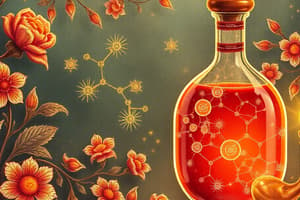Podcast
Questions and Answers
What are carbocations?
What are carbocations?
Positively charged carbons
Why are carbocations highly reactive and short-lived?
Why are carbocations highly reactive and short-lived?
Due to their positive charge and high electron deficiency
How are carbanions formed?
How are carbanions formed?
When an alkyl or aryl group donates an electron pair to an electronegative atom
What type of species are carbanions in terms of reactivity?
What type of species are carbanions in terms of reactivity?
In what type of reactions do carbanions typically participate?
In what type of reactions do carbanions typically participate?
Explain what concerted reactions are in organic chemistry.
Explain what concerted reactions are in organic chemistry.
Describe the concept of pericyclic reactions with an example.
Describe the concept of pericyclic reactions with an example.
What are carbenes and how do singlet carbenes differ from triplet carbenes?
What are carbenes and how do singlet carbenes differ from triplet carbenes?
Explain the difference between singlet and triplet nitrenes.
Explain the difference between singlet and triplet nitrenes.
How do arynes differ from traditional carbocations in terms of stability?
How do arynes differ from traditional carbocations in terms of stability?
What distinguishes arynes from other reactive intermediates such as carbocations and carbanions?
What distinguishes arynes from other reactive intermediates such as carbocations and carbanions?
Describe a unique reaction pathway that arynes can undergo, different from carbocations or carbanions.
Describe a unique reaction pathway that arynes can undergo, different from carbocations or carbanions.
How can arynes be utilized in the synthesis of complex molecules with high stereocontrol?
How can arynes be utilized in the synthesis of complex molecules with high stereocontrol?
What makes arynes valuable synthetic tools in various fields of chemistry?
What makes arynes valuable synthetic tools in various fields of chemistry?
Why are arynes considered a unique class of reactive intermediates?
Why are arynes considered a unique class of reactive intermediates?
What are the unique characteristics of arynes?
What are the unique characteristics of arynes?
How are arynes generated, and what is the process known as?
How are arynes generated, and what is the process known as?
Why must arynes be generated and consumed almost simultaneously?
Why must arynes be generated and consumed almost simultaneously?
How do arynes differ from traditional carbocations in terms of structure?
How do arynes differ from traditional carbocations in terms of structure?
What types of reactions can diphenylacetylene (PhC≡CPh) readily undergo?
What types of reactions can diphenylacetylene (PhC≡CPh) readily undergo?
Study Notes
Reactive Intermediates and Concerted Reactions: A Tale of Carbocations, Carbanions, Carbenes, Nitrenes, and Arynes
Imagine a dance floor brimming with exuberant molecules, each step and twirl contributing to a mesmerizing, yet intricate reaction. This vivid analogy describes the world of reactive intermediates and concerted reactions, a realm where carbocations, carbanions, carbenes, nitrenes, and arynes take center stage.
Reactive Intermediates
These short-lived species are generated during chemical reactions and, despite their fleeting existence, often act as key intermediates that determine the overall outcome of a reaction. Let's delve into the first two of these species:
Carbocations
Carbocations are positively charged carbons, typically formed when a bond between carbon and a more electronegative atom (e.g., halogen, oxygen, or nitrogen) breaks, and the electron pair is donated to the more electronegative atom. Carbocations are highly reactive and short-lived due to their positive charge and high electron deficiency.
Carbanions
Carbanions are negatively charged carbons, formed when an alkyl or aryl group donates an electron pair to an electronegative atom, such as hydrogen in an acid. The resulting carbanion is a strong nucleophile and typically participates in reactions involving electrophilic species.
Concerted Reactions
These reactions occur via a single, concerted molecular mechanism and involve a coordinated rearrangement of bonds within a single transition state. There are several concerted reactions of interest when discussing carbocations, carbanions, carbenes, nitrenes, and arynes.
Pericyclic Reactions
Pericyclic reactions are concerted processes in which bonds are formed or broken during a single transition state, often involving the breaking of a cyclic array of sigma bonds (6π or 4π) or the formation of new sigma bonds (6π or 4π). Some examples of pericyclic reactions include:
- Electrocyclic reactions: A cyclic array of pi bonds is rearranged to form or break a double bond. For example, the [2+2] cycloaddition reaction of ethylene to form butadiene.
- Sigmatropic rearrangements: A σ bond migrates to a new position in a different π system. For example, the [1,3] sigmatropic rearrangement in which a hydrogen or alkyl group moves from one carbon to another in a cyclopropane ring.
- Cycloaddition reactions: A pair of pi bonds in two different molecules combine to form a new sigma bond, such as the Diels-Alder reaction.
Carbenes, Nitrenes, and Arynes
Though less prevalent in organic chemistry than carbocations and carbanions, carbenes, nitrenes, and arynes play a vital role in the realm of reactive intermediates.
-
Carbenes: Carbenes are divalent carbon species with two electron domains. Carbenes can be singlet or triplet, depending on the spin of the electrons. Singlet carbenes are more stable and less reactive than triplet carbenes.
-
Nitrenes: Nitrenes are divalent nitrogen species with two electron domains. Like carbenes, nitrenes can be singlet or triplet, depending on the spin of the electrons. Singlet nitrenes are more stable and less reactive than triplet nitrenes.
-
Arynes: Arynes are divalent aromatic carbon species with two electron domains. Like carbocations, arynes have a positive charge, but it is delocalized, making them more stable than traditional carbocations.
In summary, the study of reactive intermediates and concerted reactions highlights the dynamic, almost choreographed, nature of chemical reactions, and the central role that carbenes, nitrenes, and arynes play in this exciting field. As we continue to explore these fascinating species and their roles in chemistry, we open new avenues for the design of novel synthetic methods and materials.
Studying That Suits You
Use AI to generate personalized quizzes and flashcards to suit your learning preferences.
Description
Test your knowledge on reactive intermediates like carbocations, carbanions, carbenes, nitrenes, and arynes, as well as concerted reactions such as pericyclic reactions. Explore the roles of these fascinating species in determining the outcome of chemical reactions.




